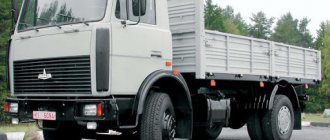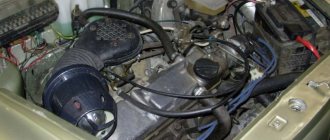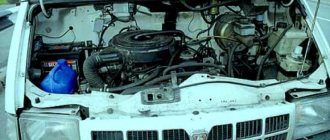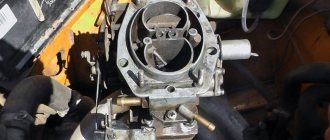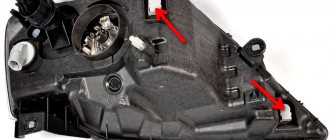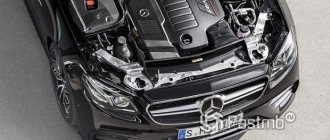Operating principle of the glow plug control unit (GPU):
When the ignition key is turned to the IGNITION
the block must provide
connecting four glow plugs to the battery (the unit must
close the contacts “12V”), as well as the CANDLE warning lamp, with a power of no more than 1.3 W. Simultaneously with setting the ignition key to the IGNITION position, the unit must begin counting the preheating time tpp and the reliable shutdown time tno=(tpp+tco). At the end of tpp, the CANDLE indicator lamp should go out.
When turning the ignition key to the STARTER position during tpp, the glow plugs must remain connected. When the ignition key is turned back to the IGNITION position, the glow plugs should turn off after tco=(120±20) s.
Wherein:
-if the ignition key is not turned to the STARTER
, the spark plugs should be turned off at the end of time
t
but;
-new switching on of the glow plugs should occur after turning the key
ignition position «0»
and re-set to the
IGNITION
.
Operating principle of the glow plug control module (MUSN-01):
ZIL-169
The plant began developing a diesel engine on its own initiative in 1971. It was assumed that the new engine would fit under the hood of a promising truck (ZIL-4331 family), which would replace the rapidly aging ZIL-130. At the same time, from the very beginning, broad unification of the main components (clutch, gearbox, etc.) of the future new product with the current flagship of the plant was envisaged. This was dictated for reasons of economy, given the colossal production volume of the ZIL-130. Be that as it may, from its gasoline predecessors, the ZIL-645 borrowed only a V-shaped cylinder arrangement and approximately the same dimensions.
In 1974, the first experimental ZIL-645 was ready. It had a displacement of 7.6 liters and a power of 160 hp. and torque 451 Nm. The first tests showed that the traction and dynamic characteristics of the engine were not enough to operate as part of a road train with a total weight of 20.5 tons. As a result, in 1976, the ZIL-645 appeared with a displacement increased to 8.74 liters and a power of 185 hp. and a torque of 510 Nm. Initially, the construction of motors was carried out in the experimental workshop of ZIL.
In parallel with this, the construction of a motor plant began in the city of Yartsevo, Smolensk region. It was planned that the Yartsevo Engine Plant would produce up to 250 thousand ZIL-645 diesel engines per year. The launch of production was supposed to take place in 1986, and until that moment production in a small series was planned to be organized at UAMZ (Ural Automotive Plant).
Advantages and disadvantages
The ZIL 645 engine has the following advantages:
- Stable operation at low speeds;
- Lack of increased fuel requirements (owners often use the 92 rather than 95 marking);
- Long service life - about 200 thousand km with no need for major repairs;
- Simplicity of design and ease of repair and installation;
- Ability to work in harsh climatic conditions;
- High degree of reliability.
The disadvantages of the ZIL 645 engine include the lack of special degree grids for adjusting the motor according to the engine advance angle and sometimes difficulties in finding spare parts for replacement.
[~DETAIL_TEXT] => The 4331 series truck became widespread and over time began to be mass produced. Its main feature was the ZIL 645 engine, the advantages of which are improved reliability, service life and performance compared to previous models of identical versions of the car. This motor is easy to maintain and does not cause headaches for the owner.
VESKO-TRANS.RU
Content
Someone in the group supplied a box with a potion and an engine from Belarus.
Arseny (Wadsworth) And I’ll say on my own behalf: Installing a Belarusian diesel engine without a turbine (81 hp) promises a huge loss of dynamics. easier to say. Shishiga will not only go 50-60 km/h.
Syren (Veronica) But the diesel is rather weak, but economical! But the turbocharged 150,000 is capricious
Pasha (to Maike) If the body is light, then there are no horses, and in my village a friend also had a diesel engine, so he accelerated to 90 km / h. And I can go on gas
Eremey (Dziko), and you buy gasoline from a warrior for 8-10 rubles per liter. and you will be happy
Pasha (to Mike) Where I live, there are no military units, there are no problems with diesel fuel on the state farm
Gazinur (Aloisio), so it’s not clear. It is worth installing a diesel engine on the 66, as it is called no. I want to install a box from ZIL 157))) the diesel power is enough.
Paul (Adinda) I have a D240 gearbox and a ZIL 5 speed gearbox. the speed is naturally 70 ceilings, but I still like it
Sasha (Godeliva) The speed will be 60.70, but it will be forever. On hills, the speed will not drop, unlike gas. The only one, unfortunately. It will be difficult to travel in winter. You just hang in the cabin: the diesel engine does not warm up properly.
Andryukha (Sankara), turbine D-243 Kamaz K-27 (Czech Republic), Zil 130 gearbox, tires from Ural OI-25), maximum speed 70 km/h))) Over rough terrain better than any Kamaz and Ural and about 131 and nothing to say!! ))) ground clearance 41.5 cm)))) Of course, there are a lot of changes, but there is a lot of meaning!!
ZIL 131 diesel. Independent SMD installation using BMZ kit.
And you need to put it in the stupa distribution, too high speed will be higher, sometimes it will not be easy, but lower than this, which will improve the ability to cross))
Characteristics of the ZIL 645 engine
This power unit is a V-shaped four-stroke diesel engine, which has a volume of 8.75 liters with a rated power of 185 horsepower. Other installation options include the following:
- number of cylinders - eight;
- maximum torque – 510 Nm;
- compression – 18.5;
- the cylinder has a diameter of one hundred and ten millimeters;
- cooling type – liquid system.
The 645 ZIL engine compares favorably with its gasoline counterparts due to its greater productivity and efficiency.
For objectivity, below are the parameters of the used options for other power plants:
- The four-stroke gasoline engine, coded 508.10, is equipped with a carburetor and liquid cooling. Its power is 150 horsepower and its volume is six liters. It runs on AI-76 fuel and has a service life of 350 thousand kilometers.
- Model 508300 with a volume of six liters has a power of 134 “horses”. This gasoline carburetor engine is equipped with an electronic injection system and complies with the Euro 3 standard.
ZIL-4331
Trucks produced at the Moscow plant named after. Likhachev have always been distinguished by their versatility. However, until 1985, only gasoline power units were installed across the entire model range. In the early 80s of the last century, the leadership of the Soviet Union assigned two automobile industrial enterprises the task of developing and producing diesel trucks.
The direction of converting both truck and bus fleets to diesel fuel in those years was considered to be promising and fundamental for all sectors of the national economy. If for the Kama Automobile Plant the production of diesel vehicles was commonplace, then the designer of the plant named after. Likhachev took on such work for the first time. The result was the release of a new model in 1986, which received the index ZIL-4331.
The truck that appeared on the roads was easily recognizable by its angular cabin with clearly defined lines. An interesting fact is that the predecessor of the ZIL-4331 was a model with the index ZIL-169, which was originally developed as a hoodless vehicle. ZIL-7E169G with a similar cabin was also one of the stages of development of the model, but the headlights and direction indicators were located on the front of the car's wings.
The final, production version of the ZIL-4331 was first presented at the automobile exhibition in Moscow in 1984.
Purpose
The main area of application of the ZIL-4331 was regional transportation over short distances. The car is distinguished by reliability, ease of maintenance and repair, as well as low operating costs. It can be confidently called a “workhorse” for various industries, agriculture, logging, and housing and communal services.
The car feels confident on sticky soils and steep climbs. The car performed well not only in various climatic zones of Russia, but also in subtropical and tropical climates. ZIL-4331 is equally reliable both on flat terrain and in high mountain areas.
About one and a half million ZIL-4331 units are in operation in Russia and countries of the near and far abroad.
Modifications
ZIL-4331 was constantly modernized throughout all years of production, changes and new elements were introduced into the design. About twenty different serial and experimental modifications of the machine were produced for various production needs. The main difference between all modifications from each other is the power units and the length of the wheelbase. The ZIL-433100 with a ZIL-645 engine and a wheelbase of 4500 mm was taken as the basis.
With full structural weight, on an asphalt section of the highway the car is capable of accelerating to 95 km/h, which was a fairly good indicator at the time the car was launched. The short wheelbase ZIL-432900 has a Belarusian diesel engine D-245.29 with a power of 105 hp. and a wheelbase of 3800mm. Three modifications ZIL-442100, ZIL-442160 and ZIL-442300 with different wheelbases are designed as truck tractors. ZIL-433104 was developed for the fire service.
The four-door cabin installed on the vehicle made it possible to accommodate seven fire brigade people in full equipment. On a long-wheelbase chassis of 5600 mm, the ZIL-4332A car was equipped with a cabin with a sleeping place for the driver and passenger. In addition, in the 2000s, some auto repair plants began installing powerful 240-horsepower YaMZ-236 engines on cars. Modifications of dump trucks with a carrying capacity of up to 6 tons and various tank trucks were put into production.
For various loading and unloading operations, the vehicle is used with an onboard manipulator of the MKS-4531 type installed on it. To carry out work at height, various types of lifts are installed on the vehicle.
Specifications
Conceived as a diesel truck, the ZIL-4331 entered production with a ZIL-508.10 carburetor engine and a five-speed gearbox. Subsequently, the car began to be equipped with diesel engines, including the naturally aspirated ZIL-645, which became the most widespread. Many technical solutions embodied in the car were advanced for their time. The car received a spacious two-door cabin with an original design and a frame structure. The engine location is front, longitudinal.
The front and rear suspensions are dependent, mounted on longitudinal semi-elliptic springs. The front suspension is balanced, the rear is balanced-spring. The driving role is performed by the rear wheels. The front wheels are controlled by steering (screw-ball nut) with hydraulic booster. Front and rear drum brakes. The front brake pads are 100 mm wide, the rear ones are 140 mm wide. The brake system is dual-circuit, with a pneumatic drive.
